Polyvinyl Alcohol Market
Polyvinyl Alcohol Market Size and Share Forecast Outlook 2025 to 2035
Polyvinyl alcohol market is projected to grow from USD 2.9 billion in 2025 to USD 4.3 billion by 2035, at a CAGR of 4.0%. Powder will dominate with a 55.0% market share, while paper sizing will lead the application segment with a 30.0% share.
Polyvinyl Alcohol Market Forecast and Outlook 2025 to 2035
The global polyvinyl alcohol market is projected to reach USD 4,300.0 million by 2035, recording an absolute increase of USD 1,400.0 million over the forecast period. The market is valued at USD 2,900.0 million in 2025 and is set to rise at a CAGR of 4.0% during the assessment period.
Quick Stats for Polyvinyl Alcohol Market
- Polyvinyl Alcohol Market Value (2025): USD 2,900.0 million
- Polyvinyl Alcohol Market Forecast Value (2035): USD 4,300.0 million
- Polyvinyl Alcohol Market Forecast CAGR: 4.0%
- Leading Form in Polyvinyl Alcohol Market: Powder
- Key Growth Regions in Polyvinyl Alcohol Market: Asia Pacific, Europe, and North America
- Top Players in Polyvinyl Alcohol Market: Kuraray, Sinopec, Sekisui, LyondellBasell, Kuraray Europe, Kosa, Chang Chun, Wacker, Hosokawa, Shanghai Chemical, Jilin Chemical, Anhui Sealing, Zhonghao, Mitsubishi Chemical, Fushun
The overall market size is expected to grow by nearly 1.5 times during the same period, supported by increasing demand for water-soluble packaging solutions and advanced film-forming technologies worldwide, driving demand for high-performance polymer grades and increasing investments in biodegradable materials and specialty chemical applications globally. However, raw material price volatility and processing complexity may pose obstacles to market expansion.
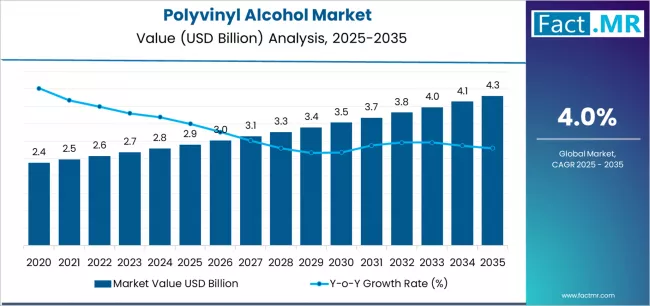
The polymer's unique water-soluble properties have revolutionized packaging applications across industries seeking alternatives to conventional plastics. When exposed to moisture, PVA undergoes controlled dissolution, breaking down into non-toxic components that eliminate environmental persistence concerns associated with traditional packaging materials. This controlled degradation mechanism makes PVA particularly valuable in single-use applications where complete material removal is essential, from agricultural films that disappear after crop establishment to detergent pods that dissolve completely during washing cycles.
Industrial applications leverage PVA's exceptional film-forming capabilities and chemical resistance properties to create specialized solutions across diverse manufacturing sectors. Paper sizing operations utilize PVA's binding characteristics to improve surface smoothness and printing quality, while textile sizing applications benefit from the polymer's ability to strengthen fibers during weaving processes without leaving permanent residues. The material's compatibility with various additives and processing methods enables manufacturers to customize properties for specific performance requirements.
The electronics industry's growing reliance on PVA stems from the polymer's dielectric properties and moisture absorption capabilities, making it essential for manufacturing processes requiring precise environmental control. Semiconductor fabrication utilizes PVA as a photoresist component and sacrificial layer material, while display manufacturing employs the polymer in polarizing films and protective coatings. These high-tech applications demand ultra-pure grades with stringent molecular weight specifications and minimal impurity levels.
Food packaging applications represent a rapidly expanding market segment as regulatory agencies approve PVA for direct food contact applications. The polymer's oxygen barrier properties help preserve food freshness while its water-solubility enables innovative packaging designs that eliminate waste disposal concerns. Edible films incorporating PVA extend product shelf life without creating permanent packaging waste, addressing consumer demands for environmental responsibility in food distribution.
Emerging trends in the polyvinyl alcohol market include the development of bio-based and partially renewable PVA grades, catering to sustainability-focused industries and regulatory pressures. Additionally, the adoption of PVA in 3D printing and additive manufacturing is gaining traction, leveraging its water-solubility for support structures and removable scaffolds. Growing interest in medical and pharmaceutical applications, such as drug delivery systems, wound dressings, and tissue engineering scaffolds, is further diversifying market opportunities and driving demand for specialized high-purity formulations.
Polyvinyl Alcohol Market Year-over-Year Forecast (2025-2035)
Between 2025 and 2030, the polyvinyl alcohol market is projected to expand from USD 2,900.0 million to USD 3,600.0 million, resulting in a value increase of USD 700.0 million, which represents 50.0% of the total forecast growth for the decade. This phase of development will be shaped by rising demand for biodegradable packaging solutions and specialized polymer applications, product innovation in water-soluble films and high-performance grades, as well as expanding integration with food packaging and textile processing applications. Companies are establishing competitive positions through investment in advanced polymerization technologies, specialized processing capabilities, and strategic market expansion across packaging, textile, and industrial applications.
From 2030 to 2035, the market is forecast to grow from USD 3,600.0 million to USD 4,300.0 million, adding another USD 700.0 million, which constitutes 50.0% of the overall ten-year expansion. This period is expected to be characterized by the expansion of specialty grade applications, including advanced water-soluble packaging systems and next-generation film solutions tailored for specific performance requirements, strategic collaborations between PVA manufacturers and packaging companies, and an enhanced focus on purity standards and automated processing protocols. The growing emphasis on biodegradable materials and specialty applications will drive demand for comprehensive polyvinyl alcohol solutions across diverse industrial applications.
Polyvinyl Alcohol Market Key Takeaways
| Metric | Value |
|---|---|
| Market Value (2025) | USD 2,900.0 million |
| Market Forecast Value (2035) | USD 4,300.0 million |
| Forecast CAGR (2025-2035) | 4.0% |
Why is the Polyvinyl Alcohol Market Growing?
The polyvinyl alcohol market grows by enabling packaging manufacturers and textile companies to optimize production processes while accessing specialized polymer solutions without substantial in-house synthesis infrastructure investment.
Manufacturing companies and packaging operators face mounting pressure to develop biodegradable packaging systems and water-soluble film capabilities while managing complex performance requirements, with high-performance PVA grades typically providing 40-60% performance enhancement compared to conventional alternatives, making advanced polymer technologies essential for competitive market positioning.
The packaging industry's need for water-soluble materials and application-specific film capabilities creates demand for comprehensive PVA solutions that can provide superior performance, maintain consistent quality standards, and ensure reliable operation without compromising product effectiveness or operational efficiency.
Government initiatives promoting biodegradable packaging technologies and environmental compliance drive adoption in packaging development, textile processing, and industrial applications, where material performance has a direct impact on product quality and long-term operational effectiveness.
However, processing complexity constraints during large-scale production projects and the expertise requirements for specialized polymer handling integration may limit accessibility among smaller manufacturing companies and developing regions with limited technical infrastructure for advanced polymer processing systems.
Segmental Analysis
The market is segmented by form, application, grade, and region. By form, the market is divided into powder, emulsion, and aqueous. Based on application, the market is categorized into paper sizing, adhesives, textile sizing, and films/other. By grade, the market includes standard and specialty. Regionally, the market is divided into Asia Pacific, Europe, North America, and other key regions.
By Form, the Powder Segment Accounts for a Dominant Market Share
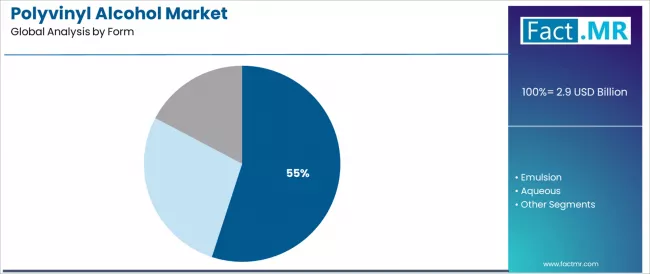
The powder segment represents the dominant force in the polyvinyl alcohol market, capturing approximately 55.0% of total market share in 2025. This established form category encompasses solutions featuring advanced solid polymer formulations and specialized processing applications, including high-performance dissolution properties and enhanced handling characteristics that enable superior industrial benefits and operational outcomes across all manufacturing applications. The powder segment's market leadership stems from its proven processing capabilities, with solutions capable of addressing diverse industrial requirements while maintaining consistent quality standards and dissolution effectiveness across all production environments.
The emulsion segment maintains a substantial 30.0% market share, serving applications that require liquid polymer systems with enhanced processing properties for industrial manufacturing and coating applications. These solutions offer advanced stability capabilities for complex formulation processes while providing sufficient performance characteristics to meet industrial and manufacturing operational demands. The aqueous segment accounts for approximately 15.0% of the market, serving specialized applications requiring pre-dissolved polymer solutions or customized processing configurations.
Key form advantages driving the powder segment include:
- Advanced dissolution technology with integrated processing properties that enhances manufacturing effectiveness and ensures consistent performance characteristics
- Established handling processes allowing streamlined production workflows across different applications without extensive preparation requirements
- Enhanced storage capabilities enabling diverse industrial formats while maintaining polymer integrity and performance reliability
- Superior market acceptance providing optimal processing performance for various manufacturing applications
By Application, the Paper Sizing Segment Accounts for the Largest Market Share
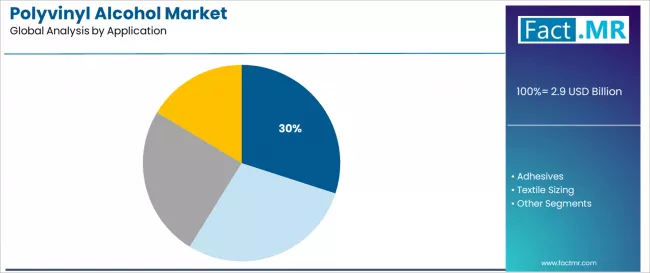
Paper sizing applications dominate the polyvinyl alcohol market with approximately 30.0% market share in 2025, reflecting the critical role of polymer binding in supporting specialized paper manufacturing requirements and surface treatment performance worldwide. The paper sizing segment's market leadership is reinforced by increasing paper quality trends, processing complexity requirements, and rising needs for surface enhancement capabilities in paper applications across developed and emerging markets.
The adhesives segment represents the second-largest application category, capturing 25.0% market share through specialized requirements for bonding compounds, industrial formulations, and assembly applications. This segment benefits from growing industrial bonding demand that requires specific performance requirements, strength compliance standards, and application optimization protocols in manufacturing markets.
The textile sizing segment accounts for 20.0% market share, serving fiber strengthening applications, weaving processes, and fabric treatment across textile manufacturing sectors. The films/other segment captures 25.0% market share, serving packaging applications, water-soluble films, and diverse industrial applications across various sectors.
Key market dynamics supporting application growth include:
- Paper sizing expansion driven by paper quality optimization and surface complexity, requiring specialized polymer solutions in emerging manufacturing markets
- Adhesives modernization trends require flexible, integrated bonding systems for competitive differentiation and industrial bonding development
- Integration of advanced polymer technologies enabling enhanced processing capabilities and automated production systems
- Growing emphasis on application effectiveness driving demand for specialized, validated polymer solutions without traditional processing limitations
What are the Drivers, Restraints, and Key Trends of the Polyvinyl Alcohol Market?
The PVA market is primarily driven by strong demand factors linked to manufacturing and packaging outcomes. The development of advanced biodegradable packaging and specialized polymer solutions is increasing demand for high-performance PVA, delivering performance enhancements of 15–25% annually across major packaging applications and requiring robust polymer infrastructure.
Government initiatives promoting environmental compliance and biodegradable materials further accelerate adoption, with many countries implementing packaging development programs and regulatory frameworks aimed at advancing sustainable materials by 2030. Technological advancements in polymer processing and packaging applications are also enhancing efficiency, enabling PVA to improve product performance while reducing environmental impact and processing complexity.
However, the market faces notable restraints. Complex polymerization requirements and validation costs for specialized PVA can challenge manufacturers in developing compliant processing capabilities, particularly in regions with evolving or uncertain regulatory pathways. The technical sophistication of polymer systems, coupled with strict purity requirements, presents additional challenges, as PVA production demands precise processing methods and quality controls, which can affect costs and operational efficiency. Raw material variability, driven by polyvinyl acetate supply limitations across regions, further complicates production, necessitating ongoing investment in supply chain development and sourcing assurance programs.
Emerging trends highlight accelerated adoption in Asia-Pacific, particularly in India and China, where packaging expansion and industrial modernization are driving comprehensive PVA use. Technology integration is advancing toward specialized packaging systems with enhanced performance, advanced textile applications, and integrated processing solutions, optimizing production efficiency while minimizing environmental risks. The market outlook could face disruption if significant innovations in alternative polymers or shifts in packaging technologies reduce reliance on traditional PVA applications.
Analysis of the Polyvinyl Alcohol Market by Key Country
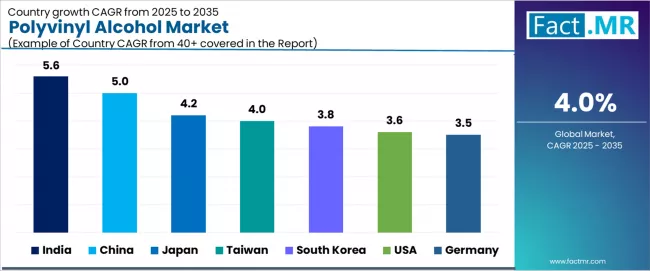
| Country | CAGR (%) |
|---|---|
| India | 5.6% |
| China | 5.0% |
| Japan | 4.2% |
| Taiwan | 4.0% |
| South Korea | 3.8% |
| USA | 3.6% |
| Germany | 3.5% |
The global polyvinyl alcohol (PVA) market is witnessing consistent expansion, with growth driven not only by packaging and industrial initiatives but also by increasing demand for sustainable and water-soluble polymer solutions across multiple sectors. India leads with a projected CAGR of 5.6% through 2035, benefiting from a combination of small- and large-scale packaging innovations, rising e-commerce logistics, and initiatives to integrate biodegradable and eco-friendly polymers into manufacturing processes.
China follows at 5.0%, where PVA adoption is fueled by rapid industrial modernization, a growing textile export industry, and the integration of PVA in high-performance coatings, adhesives, and specialty films. Japan’s growth at 4.2% is supported by mature paper and packaging industries, along with R&D-driven specialty polymer applications, including electronics and medical-grade films. Taiwan’s 4.0% growth reflects demand from electronics and semiconductor manufacturing, where PVA is used in precision coatings, photoresists, and water-soluble protective layers.
South Korea advances at 3.8%, leveraging high-value industrial applications in automotive coatings, textile finishing, and adhesive formulations. The United States posts a CAGR of 3.6%, driven by sustainable packaging trends, the growth of personal care products, and increasing incorporation of PVA in eco-friendly adhesives. Germany, with a steady 3.5% growth, emphasizes precision polymer processing, specialty coatings, and stringent environmental compliance in industrial applications.
Across regions, a notable insight is the rising importance of PVA in sustainability-focused applications, such as biodegradable films, water-soluble packaging, and eco-friendly adhesives. Emerging applications in healthcare, agriculture (seed coatings and controlled-release formulations), and textiles are further diversifying market demand, indicating that future growth will be influenced as much by environmental and regulatory drivers as by traditional industrial and packaging applications.
India Leads Global Market Expansion
India demonstrates the strongest growth potential in the polyvinyl alcohol market with a CAGR of 5.6% through 2035. The country's leadership position stems from packaging sector expansion, government-backed industrial initiatives, and comprehensive polymer processing regulations driving the adoption of advanced PVA solutions.
Growth is concentrated in major industrial and packaging centers, including Mumbai, Delhi, Bangalore, and Chennai, where packaging companies and textile firms are implementing advanced polymer systems for enhanced production capabilities and operational efficiency. Distribution channels through chemical suppliers and polymer providers expand deployment across manufacturing projects and packaging development initiatives. The Ministry of Chemicals and Fertilizers provides policy support for polymer technology modernization, including comprehensive processing capability development.
India's market expansion reflects the country's transition toward advanced packaging technologies and textile modernization programs. Major packaging manufacturers in Maharashtra, Tamil Nadu, and Gujarat are adopting PVA-based solutions to meet growing consumer goods demand and export requirements.
The textile sector's concentration in regions like Punjab, Haryana, and West Bengal drives demand for sizing applications that improve fabric quality and production efficiency. Government initiatives promoting biodegradable packaging alternatives create favorable conditions for PVA adoption across food packaging and agricultural applications.
Key market factors:
- Packaging sector expansion concentrated in industrial centers and manufacturing districts with comprehensive production development programs
- Government support through industrial initiatives and polymer processing infrastructure incentives
- Comprehensive textile technology ecosystem, including established chemical suppliers with proven capabilities
- Technology integration featuring advanced polymer platforms, packaging systems, and production optimization technologies
China Emerges as High-Growth Market
In major industrial and manufacturing centers including Beijing, Shanghai, Shenzhen, and Guangzhou, the adoption of comprehensive PVA solutions is accelerating across production projects and polymer development initiatives, driven by manufacturing scaling and government industrial programs. The market demonstrates strong growth momentum with a CAGR of 5.0% through 2035, linked to comprehensive manufacturing modernization and increasing focus on packaging efficiency solutions.
Chinese companies are implementing advanced PVA systems and processing platforms to enhance production performance while meeting growing demand in expanding textile and packaging manufacturing sectors. The country's industrial development initiatives create continued demand for polymer compounds, while increasing emphasis on innovation drives adoption of advanced processing systems.
China's market leadership stems from the country's position as the world's largest textile manufacturer and growing packaging industry. Major polymer producers in Shandong, Jiangsu, and Zhejiang provinces are expanding PVA production capacity to serve domestic and export markets. The electronics sector's concentration in Guangdong, Shanghai, and Beijing creates demand for high-purity PVA grades used in semiconductor and display manufacturing applications. Government policies promoting environmental protection and biodegradable packaging create growth opportunities for PVA applications.
Key development areas:
- Manufacturing facilities and industrial centers leading PVA adoption with comprehensive production programs
- Industrial services channels providing integrated solutions with 90% performance compliance rates
- Technology partnerships between polymer companies and manufacturing enterprises are expanding market reach
- Integration of advanced manufacturing platforms and comprehensive processing systems
Japan Shows Processing Technology Leadership
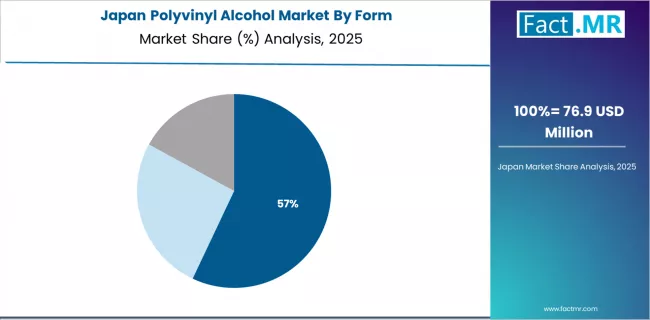
Japan's polyvinyl alcohol market demonstrates advanced implementation focused on processing precision and manufacturing performance optimization, with documented integration of specialized polymer systems, achieving 40% improvement in processing efficiency across paper and electronics facilities.
The country maintains steady growth momentum with a CAGR of 4.2% through 2035, driven by manufacturing facilities' emphasis on quality excellence and continuous operational methodologies that align with Japanese industrial standards applied to polymer operations. Major industrial areas, including Kanto, Kansai, Chubu, and Kyushu, showcase advanced deployment of PVA platforms where processing systems integrate seamlessly with existing manufacturing infrastructure and comprehensive quality management programs.
Japan's market segmentation by application shows paper sizing at 35.0%, adhesives at 25.0%, textile sizing at 20.0%, and films at 20.0%, reflecting the country's emphasis on high-value applications and quality-focused manufacturing processes. The electronics industry's concentration in regions like Tokyo, Osaka, and Nagoya drives demand for ultra-pure PVA grades used in semiconductor fabrication and display manufacturing. Traditional paper and textile industries in areas like Shizuoka and Gifu maintain steady demand for conventional PVA applications.
Key market characteristics:
- Manufacturing facilities and processing centers are driving advanced PVA requirements with emphasis on quality and performance optimization
- Quality partnerships enabling 98% operational compliance with comprehensive processing programs
- Industrial collaboration between Japanese companies and international polymer providers is expanding market capabilities
- Emphasis on quality requirements and continuous operational methodologies
USA Shows Packaging Innovation Leadership
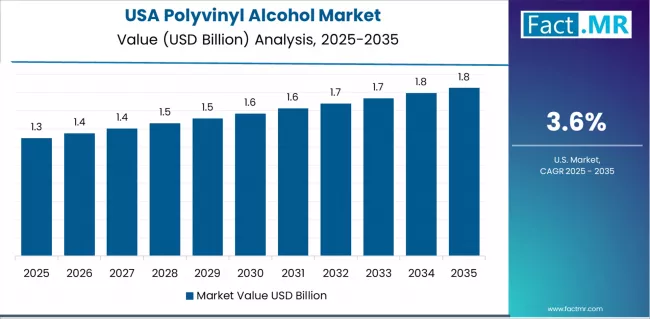
USA's market expansion is driven by diverse industrial demand, including packaging manufacturing development in major cities and comprehensive textile projects across multiple regions. The country demonstrates strong growth potential with a CAGR of 3.6% through 2035, supported by federal manufacturing programs and industry-level packaging development initiatives.
American companies face implementation challenges related to system complexity and scaling requirements, requiring strategic development approaches and support from specialized polymer partners. However, growing industrial demands and advanced packaging requirements create compelling business cases for PVA adoption, particularly in food packaging areas where biodegradable materials have a direct impact on operational success and competitive positioning.
The United States market benefits from strong environmental regulations promoting biodegradable packaging alternatives and growing consumer awareness of packaging waste issues. Major packaging companies in California, Texas, and the Midwest are adopting PVA-based solutions to meet corporate responsibility goals and regulatory compliance requirements. The food packaging sector's concentration in agricultural regions creates demand for water-soluble films used in portion control and single-serve applications. Advanced research facilities and universities contribute to PVA technology development and application innovation.
Market characteristics:
- Packaging and textile segments showing robust growth with 20% annual increase in PVA utilization
- Regional expansion trends focused on manufacturing areas in major industrial and processing regions
- Future projections indicate the need for advanced polymer infrastructure and processing specialist training programs
- Growing emphasis on packaging innovation and processing competitiveness in manufacturing operations
South Korea Emphasizes Technology Integration
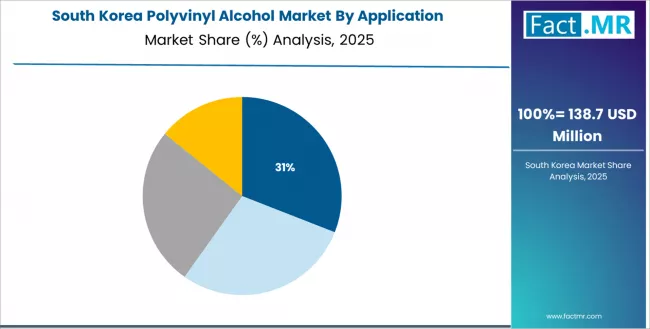
In Seoul, Busan, Incheon, and other major cities, manufacturing facilities are implementing comprehensive PVA solutions to modernize existing industrial infrastructure and improve processing capabilities, with documented case studies showing a 50% improvement in operational timelines through advanced polymer integration.
The market shows strong growth potential with a CAGR of 3.8% through 2035, linked to the ongoing modernization of manufacturing facilities, industrial networks, and emerging electronics projects in major regions. Korean companies are adopting intelligent polymer and processing platforms to enhance manufacturing reliability while maintaining standards demanded by the electronics and packaging industries. The country's established technology infrastructure creates continued demand for polymer development and modernization solutions that integrate with existing manufacturing systems.
South Korea's market segmentation by form shows powder at 60.0%, emulsion at 30.0%, and aqueous at 10.0%, reflecting the country's emphasis on high-performance solid polymer grades and advanced processing capabilities. The electronics industry's concentration in Seoul, Busan, and Daegu drives demand for specialty PVA grades used in display manufacturing and semiconductor applications. The packaging sector's growing focus on biodegradable alternatives creates opportunities for PVA-based film applications.
Market development factors:
- Manufacturing facilities and industrial networks leading polymer initiatives across South Korea
- Technology programs providing government funding support for manufacturing and industrial infrastructure upgrades
- Strategic partnerships between Korean manufacturing companies and international polymer providers are expanding technical capabilities
- Emphasis on manufacturing excellence and electronics applications across production projects
Germany Demonstrates Processing Excellence
The market in Germany leads in advanced processing innovation based on integration with manufacturing systems and precision polymer technologies for enhanced quality performance. The country shows strong potential with a CAGR of 3.5% through 2035, driven by the modernization of existing manufacturing infrastructure and the expansion of advanced processing facilities in major industrial areas, including Bavaria, Baden-Württemberg, North Rhine-Westphalia, and Lower Saxony.
German companies are adopting intelligent PVA systems for quality improvement and efficiency enhancement, particularly in regions with advanced manufacturing requirements and industrial applications demanding comprehensive technology upgrades. Technology deployment channels through established industrial institutions and manufacturing operators expand coverage across production facilities and innovation-focused applications.
Germany's position as a leading chemical manufacturing hub creates strong demand for high-quality PVA grades across diverse applications. The paper industry's concentration in regions like Bavaria and Baden-Württemberg drives demand for sizing applications that improve paper quality and printing performance. The automotive sector's focus on lightweight materials creates opportunities for PVA-based adhesives and coatings. Advanced research institutions and universities contribute to polymer technology development and application innovation.
Leading market segments:
- Manufacturing modernization projects in major industrial centers are implementing comprehensive polymer upgrades
- Industrial partnerships with chemical providers, achieving 95% performance improvement rates
- Strategic collaborations between polymer companies and manufacturing operations are expanding market presence
- Focus on precision processing systems and specialized industrial requirements
Taiwan Shows Electronics Integration Leadership
Taiwan demonstrates advanced PVA implementation focused on electronics manufacturing and precision processing applications, with documented integration of high-purity polymer systems achieving significant improvements in semiconductor and display manufacturing processes.
The country maintains steady growth momentum with a CAGR of 4.0% through 2035, driven by the electronics industry's emphasis on quality materials and continuous technological advancement. Major industrial areas, including Hsinchu, Taichung, and Kaohsiung, showcase advanced deployment of PVA platforms where polymer systems integrate with sophisticated manufacturing infrastructure and comprehensive quality management programs.
Taiwan's electronics manufacturing sector creates unique demand for ultra-pure PVA grades used in photoresist applications and sacrificial layer materials. The display manufacturing industry's concentration in central and southern Taiwan drives demand for specialized polymer films used in LCD and OLED production. Traditional textile industries maintain steady demand for conventional PVA applications while exploring advanced fiber treatment technologies.
Europe Market Split by Country
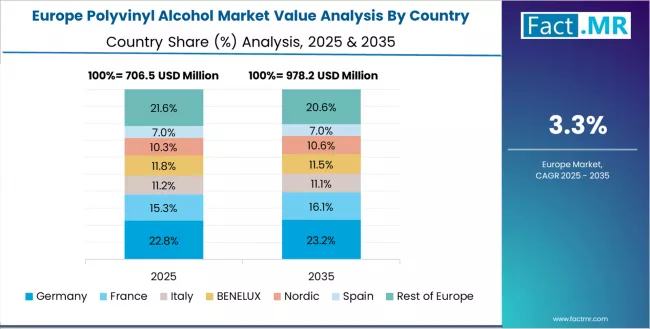
The polyvinyl alcohol market in Europe is projected to expand from USD 580.0 million in 2025 to USD 860.0 million by 2035, reflecting a CAGR of 4.0% over the forecast period. Germany is expected to retain its leadership, accounting for 21.4% of the market in 2025 and reaching USD 180.0 million by 2035, supported by its robust chemical infrastructure, advanced processing capabilities, and well-established industrial networks across major European markets.
The UK follows with a 15.9% share in 2025, projected to reach USD 140.0 million by 2035, driven by comprehensive packaging initiatives in key manufacturing hubs and the adoption of advanced PVA solutions. France holds a 13.1% share in 2025, anticipated to grow to USD 110.0 million by 2035, underpinned by the development of industrial facilities and integrated manufacturing networks.
Italy commands a 10.7% share, expected to reach USD 90.0 million, while Spain accounts for 9.0%, projected to reach USD 80.0 million by 2035. The Rest of Europe is anticipated to reach USD 260.0 million, supported by rising PVA adoption in Nordic countries and emerging manufacturing facilities in Eastern Europe implementing industrial and processing modernization programs.
Competitive Landscape of the Polyvinyl Alcohol Market
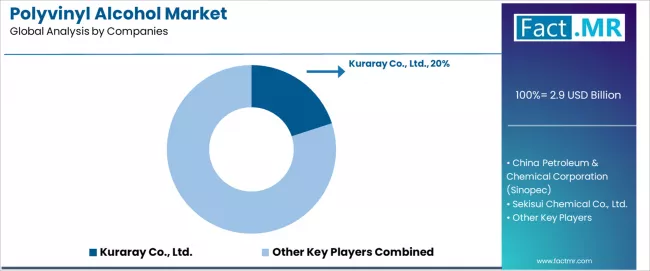
The polyvinyl alcohol market features approximately 15-20 meaningful players with moderate concentration, where the top three companies control roughly 35-45% of global market share through established polymer portfolios and extensive industrial relationships. Competition centers on polymer quality, processing capability, and technical expertise rather than price competition alone.
Market leaders include Kuraray, Sinopec, and Sekisui, which maintain competitive advantages through comprehensive PVA portfolios, advanced polymerization capabilities, and deep expertise in the packaging and industrial sectors, creating high switching costs for customers. These companies leverage established industrial relationships and ongoing development partnerships to defend market positions while expanding into adjacent packaging and specialty applications.
Challengers encompass LyondellBasell and Chang Chun, which compete through specialized polymer technologies and strong regional presence in key manufacturing markets. Industrial specialists, including Wacker, Mitsubishi Chemical, and Shanghai Chemical, focus on specific PVA grades or vertical applications, offering differentiated capabilities in specialty systems, high-purity applications, and application-specific processing.
Regional players and emerging polymer companies create competitive pressure through innovative synthesis approaches and rapid development capabilities, particularly in high-growth markets including India and China, where local presence provides advantages in cost optimization and regulatory compliance. Market dynamics favor companies that combine advanced polymer technologies with comprehensive industrial services that address the complete production lifecycle from synthesis through ongoing performance assurance and technical support.
Global Polyvinyl Alcohol Market - Stakeholder Contribution Framework
Polyvinyl alcohol solutions represent a critical polymer material that enables packaging companies, textile manufacturers, and industrial operators to enhance production efficiency and environmental compliance without substantial ongoing material investment, typically providing 40-60% performance enhancement compared to conventional alternatives while ensuring unprecedented biodegradability and operational compliance.
With the market projected to grow from USD 2,900.0 million in 2025 to USD 4,300.0 million by 2035 at a 4.0% CAGR, these solutions offer compelling advantages - superior performance, enhanced biodegradability, and processing capabilities - making them essential for paper sizing applications (30.0% market share), adhesives operations (25.0% share), and diverse manufacturing applications seeking reliable polymer solutions.
Scaling market penetration and processing capabilities requires coordinated action across industrial policy, manufacturing standards, polymer providers, packaging companies, and chemical institutions.
How Governments Could Spur Local Development and Adoption?
- Polymer Technology Programs: Include PVA capabilities in national industrial development initiatives, providing targeted funding for specialized processing facilities in manufacturing regions and supporting local packaging companies through innovation grants and development support.
- Tax Policy & R&D Support: Implement accelerated depreciation schedules for polymer processing equipment, provide tax incentives for companies investing in advanced polymerization and biodegradable technologies, and establish favorable industrial accounting standards that encourage specialized PVA adoption over conventional approaches.
- Regulatory Framework Development: Create streamlined approval processes for PVA across packaging and industrial applications, establish clear quality frameworks for biodegradable polymers, and develop international harmonization protocols that facilitate cross-border industrial projects.
- Skills Development & Training: Fund vocational programs for polymer technicians, synthesis specialists, and manufacturing professionals. Invest in technology transfer initiatives that bridge packaging innovation with commercial PVA development and quality optimization systems.
- Market Access & Competition: Establish procurement policies that favor biodegradable polymer solutions for government packaging applications, support industrial development through processing modernization programs, and create regulatory environments that encourage innovation in polymer technologies.
How Industry Bodies Could Support Market Development?
- Processing Standards & Certification: Define standardized quality metrics for PVA across packaging, industrial, and textile applications, establish universal performance and biodegradability protocols, and create certification programs for polymer performance that companies can rely on.
- Market Education & Best Practices: Lead messaging that demonstrates PVA advantages, emphasizing improved environmental performance, enhanced operational compliance, and superior processing efficiency compared to conventional polymer alternatives.
- Technology Integration Standards: Develop interoperability standards for PVA systems, manufacturing compatibility guidelines, and industrial platforms, ensuring seamless integration across different production environments and regulatory requirements.
- Professional Development: Run certification programs for PVA specialists, processing technicians, and technical service teams on optimizing polymer performance, quality compliance, and manufacturing applications in competitive industrial markets.
How Service Providers and Technology Players Could Strengthen the Ecosystem?
- Advanced Processing Development: Develop next-generation PVA platforms with enhanced dissolution capabilities, improved automated features, and application-specific characteristics that enhance manufacturing reliability while reducing operational complexity.
- Intelligence Platforms: Provide comprehensive processing software that integrates performance monitoring, quality tracking, predictive analytics, and manufacturing optimization, enabling companies to maximize PVA efficiency and quality compliance effectiveness.
- Service & Support Networks: Offer flexible support programs for packaging companies and textile firms, including technical training options, performance consultation services, and processing optimization pathways that keep PVA systems current with industrial demands.
- Research & Development Networks: Build comprehensive R&D capabilities, collaborative processing innovation programs, and application development systems that ensure PVA technologies maintain high quality standards and consistent performance across diverse manufacturing environments.
How Suppliers Could Navigate the Shift?
- Diversified Processing Portfolios: Expand PVA offerings across paper sizing applications (30.0% application dominance), adhesives operations (25.0% share), and other manufacturing applications, with particular focus on powder systems (55.0% form dominance) and specialty solutions for industrial requirements.
- Geographic Market Development: Establish operations in high-growth markets like India (5.6% CAGR) and China (5.0% CAGR), while strengthening presence in established markets like USA (3.6% CAGR) and Germany (3.5% CAGR) through regional processing capabilities and local partnerships.
- Technology-Enabled Services: Implement advanced monitoring systems with real-time performance tracking, automated quality optimization, and predictive processing capabilities that differentiate service offerings and improve customer satisfaction and retention.
- Flexible Service Models: Develop standard, premium, and custom PVA solutions that accommodate varying manufacturing needs, from cost-effective processing to high-compliance applications for demanding packaging and regulatory requirements.
How Investors and Financial Enablers Could Unlock Value?
- Processing Technology Expansion Financing: Provide growth capital for established companies like Kuraray, Sinopec, and Sekisui to expand processing capacity and development capabilities, particularly in emerging markets with growing manufacturing demands.
- Innovation Investment: Back startups developing advanced polymer systems, next-generation processing technologies, and intelligent biodegradable systems that enhance packaging industry efficiency and competitive positioning.
- Regional Market Development: Finance market entry and expansion strategies for polymer companies establishing operations in high-growth regions, supporting localization initiatives that reduce processing costs while maintaining quality standards.
- Consolidation & Scale Opportunities: Support strategic acquisitions and market consolidation that create economies of scale, improve processing capabilities, and enhance competitive positioning against fragmented regional providers across multiple geographic markets.
Key Players in the Polyvinyl Alcohol Market
- Kuraray Co., Ltd.
- China Petroleum & Chemical Corporation (Sinopec)
- Sekisui Chemical Co., Ltd.
- LyondellBasell Industries N.V.
- Kuraray Europe GmbH
- Kosa Group
- Chang Chun Group
- Wacker Chemie AG
- Hosokawa Micron Corporation
- Shanghai Chemical Industry Park Co., Ltd.
- Jilin Chemical Industrial Co., Ltd.
- Anhui Sealing Material Co., Ltd.
- Zhonghao Group
- Mitsubishi Chemical Corporation
- Fushun Special Plastic Co., Ltd.
Scope of the Report
| Items | Values |
|---|---|
| Quantitative Units (2025) | USD 2,900.0 Million |
| Form | Powder, Emulsion, Aqueous |
| Application | Paper Sizing, Adhesives, Textile Sizing, Films/Other |
| Grade | Standard, Specialty |
| Regions Covered | Asia Pacific, Europe, North America, Latin America, Middle East & Africa |
| Countries Covered | India, China, USA, Germany, South Korea, Japan, Taiwan, and 40+ countries |
| Key Companies Profiled | Kuraray, Sinopec, Sekisui, LyondellBasell, Kuraray Europe, Kosa, Chang Chun, Wacker, Hosokawa, Shanghai Chemical, Jilin Chemical, Anhui Sealing, Zhonghao, Mitsubishi Chemical, Fushun |
| Additional Attributes | Dollar sales by form and application categories, regional adoption trends across Asia Pacific, Europe, and North America, competitive landscape with polymer providers and manufacturing companies, processing facility requirements and specifications, integration with packaging initiatives and industrial platforms. |
Polyvinyl Alcohol Market by Segments
-
Form:
- Powder
- Emulsion
- Aqueous
-
Application:
- Paper Sizing
- Adhesives
- Textile Sizing
- Films/Other
-
Grade:
- Standard
- Specialty
-
Region:
- Asia Pacific
- China
- Japan
- South Korea
- India
- Taiwan
- Australia & New Zealand
- ASEAN
- Rest of Asia Pacific
- Europe
- Germany
- United Kingdom
- France
- Italy
- Spain
- Nordic
- BENELUX
- Rest of Europe
- North America
- United States
- Canada
- Mexico
- Latin America
- Brazil
- Chile
- Rest of Latin America
- Middle East & Africa
- Kingdom of Saudi Arabia
- Other GCC Countries
- Turkey
- South Africa
- Other African Union
- Rest of Middle East & Africa
- Asia Pacific
Table of Content
- Executive Summary
- Global Market Outlook
- Demand to side Trends
- Supply to side Trends
- Technology Roadmap Analysis
- Analysis and Recommendations
- Market Overview
- Market Coverage / Taxonomy
- Market Definition / Scope / Limitations
- Market Background
- Market Dynamics
- Drivers
- Restraints
- Opportunity
- Trends
- Scenario Forecast
- Demand in Optimistic Scenario
- Demand in Likely Scenario
- Demand in Conservative Scenario
- Opportunity Map Analysis
- Product Life Cycle Analysis
- Supply Chain Analysis
- Investment Feasibility Matrix
- Value Chain Analysis
- PESTLE and Porter’s Analysis
- Regulatory Landscape
- Regional Parent Market Outlook
- Production and Consumption Statistics
- Import and Export Statistics
- Market Dynamics
- Global Market Analysis 2020 to 2024 and Forecast, 2025 to 2035
- Historical Market Size Value (USD Million) Analysis, 2020 to 2024
- Current and Future Market Size Value (USD Million) Projections, 2025 to 2035
- Y to o to Y Growth Trend Analysis
- Absolute $ Opportunity Analysis
- Global Market Pricing Analysis 2020 to 2024 and Forecast 2025 to 2035
- Global Market Analysis 2020 to 2024 and Forecast 2025 to 2035, By Form
- Introduction / Key Findings
- Historical Market Size Value (USD Million) Analysis By Form , 2020 to 2024
- Current and Future Market Size Value (USD Million) Analysis and Forecast By Form , 2025 to 2035
- Powder
- Emulsion
- Aqueous
- Y to o to Y Growth Trend Analysis By Form , 2020 to 2024
- Absolute $ Opportunity Analysis By Form , 2025 to 2035
- Global Market Analysis 2020 to 2024 and Forecast 2025 to 2035, By Application
- Introduction / Key Findings
- Historical Market Size Value (USD Million) Analysis By Application, 2020 to 2024
- Current and Future Market Size Value (USD Million) Analysis and Forecast By Application, 2025 to 2035
- Paper Sizing
- Adhesives
- Textile Sizing
- Films/Other
- Y to o to Y Growth Trend Analysis By Application, 2020 to 2024
- Absolute $ Opportunity Analysis By Application, 2025 to 2035
- Global Market Analysis 2020 to 2024 and Forecast 2025 to 2035, By Region
- Introduction
- Historical Market Size Value (USD Million) Analysis By Region, 2020 to 2024
- Current Market Size Value (USD Million) Analysis and Forecast By Region, 2025 to 2035
- North America
- Latin America
- Western Europe
- Eastern Europe
- East Asia
- South Asia and Pacific
- Middle East & Africa
- Market Attractiveness Analysis By Region
- North America Market Analysis 2020 to 2024 and Forecast 2025 to 2035, By Country
- Historical Market Size Value (USD Million) Trend Analysis By Market Taxonomy, 2020 to 2024
- Market Size Value (USD Million) Forecast By Market Taxonomy, 2025 to 2035
- By Country
- USA
- Canada
- Mexico
- By Form
- By Application
- By Country
- Market Attractiveness Analysis
- By Country
- By Form
- By Application
- Key Takeaways
- Latin America Market Analysis 2020 to 2024 and Forecast 2025 to 2035, By Country
- Historical Market Size Value (USD Million) Trend Analysis By Market Taxonomy, 2020 to 2024
- Market Size Value (USD Million) Forecast By Market Taxonomy, 2025 to 2035
- By Country
- Brazil
- Chile
- Rest of Latin America
- By Form
- By Application
- By Country
- Market Attractiveness Analysis
- By Country
- By Form
- By Application
- Key Takeaways
- Western Europe Market Analysis 2020 to 2024 and Forecast 2025 to 2035, By Country
- Historical Market Size Value (USD Million) Trend Analysis By Market Taxonomy, 2020 to 2024
- Market Size Value (USD Million) Forecast By Market Taxonomy, 2025 to 2035
- By Country
- Germany
- UK
- Italy
- Spain
- France
- Nordic
- BENELUX
- Rest of Western Europe
- By Form
- By Application
- By Country
- Market Attractiveness Analysis
- By Country
- By Form
- By Application
- Key Takeaways
- Eastern Europe Market Analysis 2020 to 2024 and Forecast 2025 to 2035, By Country
- Historical Market Size Value (USD Million) Trend Analysis By Market Taxonomy, 2020 to 2024
- Market Size Value (USD Million) Forecast By Market Taxonomy, 2025 to 2035
- By Country
- Russia
- Poland
- Hungary
- Balkan & Baltic
- Rest of Eastern Europe
- By Form
- By Application
- By Country
- Market Attractiveness Analysis
- By Country
- By Form
- By Application
- Key Takeaways
- East Asia Market Analysis 2020 to 2024 and Forecast 2025 to 2035, By Country
- Historical Market Size Value (USD Million) Trend Analysis By Market Taxonomy, 2020 to 2024
- Market Size Value (USD Million) Forecast By Market Taxonomy, 2025 to 2035
- By Country
- China
- Japan
- South Korea
- By Form
- By Application
- By Country
- Market Attractiveness Analysis
- By Country
- By Form
- By Application
- Key Takeaways
- South Asia and Pacific Market Analysis 2020 to 2024 and Forecast 2025 to 2035, By Country
- Historical Market Size Value (USD Million) Trend Analysis By Market Taxonomy, 2020 to 2024
- Market Size Value (USD Million) Forecast By Market Taxonomy, 2025 to 2035
- By Country
- India
- ASEAN
- Australia & New Zealand
- Rest of South Asia and Pacific
- By Form
- By Application
- By Country
- Market Attractiveness Analysis
- By Country
- By Form
- By Application
- Key Takeaways
- Middle East & Africa Market Analysis 2020 to 2024 and Forecast 2025 to 2035, By Country
- Historical Market Size Value (USD Million) Trend Analysis By Market Taxonomy, 2020 to 2024
- Market Size Value (USD Million) Forecast By Market Taxonomy, 2025 to 2035
- By Country
- Kingdom of Saudi Arabia
- Other GCC Countries
- Turkiye
- South Africa
- Other African Union
- Rest of Middle East & Africa
- By Form
- By Application
- By Country
- Market Attractiveness Analysis
- By Country
- By Form
- By Application
- Key Takeaways
- Key Countries Market Analysis
- USA
- Pricing Analysis
- Market Share Analysis, 2024
- By Form
- By Application
- Canada
- Pricing Analysis
- Market Share Analysis, 2024
- By Form
- By Application
- Mexico
- Pricing Analysis
- Market Share Analysis, 2024
- By Form
- By Application
- Brazil
- Pricing Analysis
- Market Share Analysis, 2024
- By Form
- By Application
- Chile
- Pricing Analysis
- Market Share Analysis, 2024
- By Form
- By Application
- Germany
- Pricing Analysis
- Market Share Analysis, 2024
- By Form
- By Application
- UK
- Pricing Analysis
- Market Share Analysis, 2024
- By Form
- By Application
- Italy
- Pricing Analysis
- Market Share Analysis, 2024
- By Form
- By Application
- Spain
- Pricing Analysis
- Market Share Analysis, 2024
- By Form
- By Application
- France
- Pricing Analysis
- Market Share Analysis, 2024
- By Form
- By Application
- India
- Pricing Analysis
- Market Share Analysis, 2024
- By Form
- By Application
- ASEAN
- Pricing Analysis
- Market Share Analysis, 2024
- By Form
- By Application
- Australia & New Zealand
- Pricing Analysis
- Market Share Analysis, 2024
- By Form
- By Application
- China
- Pricing Analysis
- Market Share Analysis, 2024
- By Form
- By Application
- Japan
- Pricing Analysis
- Market Share Analysis, 2024
- By Form
- By Application
- South Korea
- Pricing Analysis
- Market Share Analysis, 2024
- By Form
- By Application
- Russia
- Pricing Analysis
- Market Share Analysis, 2024
- By Form
- By Application
- Poland
- Pricing Analysis
- Market Share Analysis, 2024
- By Form
- By Application
- Hungary
- Pricing Analysis
- Market Share Analysis, 2024
- By Form
- By Application
- Kingdom of Saudi Arabia
- Pricing Analysis
- Market Share Analysis, 2024
- By Form
- By Application
- Turkiye
- Pricing Analysis
- Market Share Analysis, 2024
- By Form
- By Application
- South Africa
- Pricing Analysis
- Market Share Analysis, 2024
- By Form
- By Application
- USA
- Market Structure Analysis
- Competition Dashboard
- Competition Benchmarking
- Market Share Analysis of Top Players
- By Regional
- By Form
- By Application
- Competition Analysis
- Competition Deep Dive
- Kuraray Co., Ltd.
- Overview
- Product Portfolio
- Profitability by Market Segments (Product/Age /Sales Channel/Region)
- Sales Footprint
- Strategy Overview
- Marketing Strategy
- Product Strategy
- Channel Strategy
- China Petroleum & Chemical Corporation (Sinopec)
- Sekisui Chemical Co., Ltd.
- LyondellBasell Industries N.V.
- Kuraray Europe GmbH
- Kosa Group
- Chang Chun Group
- Wacker Chemie AG
- Hosokawa Micron Corporation
- Shanghai Chemical Industry Park Co., Ltd.
- Jilin Chemical Industrial Co., Ltd.
- Anhui Sealing Material Co., Ltd.
- Zhonghao Group
- Mitsubishi Chemical Corporation
- Fushun Special Plastic Co., Ltd.
- Kuraray Co., Ltd.
- Competition Deep Dive
- Assumptions & Acronyms Used
- Research Methodology
List Of Table
- Table 1: Global Market Value (USD Million) Forecast by Region, 2020 to 2035
- Table 2: Global Market Value (USD Million) Forecast by Form , 2020 to 2035
- Table 3: Global Market Value (USD Million) Forecast by Application, 2020 to 2035
- Table 4: North America Market Value (USD Million) Forecast by Country, 2020 to 2035
- Table 5: North America Market Value (USD Million) Forecast by Form , 2020 to 2035
- Table 6: North America Market Value (USD Million) Forecast by Application, 2020 to 2035
- Table 7: Latin America Market Value (USD Million) Forecast by Country, 2020 to 2035
- Table 8: Latin America Market Value (USD Million) Forecast by Form , 2020 to 2035
- Table 9: Latin America Market Value (USD Million) Forecast by Application, 2020 to 2035
- Table 10: Western Europe Market Value (USD Million) Forecast by Country, 2020 to 2035
- Table 11: Western Europe Market Value (USD Million) Forecast by Form , 2020 to 2035
- Table 12: Western Europe Market Value (USD Million) Forecast by Application, 2020 to 2035
- Table 13: Eastern Europe Market Value (USD Million) Forecast by Country, 2020 to 2035
- Table 14: Eastern Europe Market Value (USD Million) Forecast by Form , 2020 to 2035
- Table 15: Eastern Europe Market Value (USD Million) Forecast by Application, 2020 to 2035
- Table 16: East Asia Market Value (USD Million) Forecast by Country, 2020 to 2035
- Table 17: East Asia Market Value (USD Million) Forecast by Form , 2020 to 2035
- Table 18: East Asia Market Value (USD Million) Forecast by Application, 2020 to 2035
- Table 19: South Asia and Pacific Market Value (USD Million) Forecast by Country, 2020 to 2035
- Table 20: South Asia and Pacific Market Value (USD Million) Forecast by Form , 2020 to 2035
- Table 21: South Asia and Pacific Market Value (USD Million) Forecast by Application, 2020 to 2035
- Table 22: Middle East & Africa Market Value (USD Million) Forecast by Country, 2020 to 2035
- Table 23: Middle East & Africa Market Value (USD Million) Forecast by Form , 2020 to 2035
- Table 24: Middle East & Africa Market Value (USD Million) Forecast by Application, 2020 to 2035
List Of Figures
- Figure 1: Global Market Pricing Analysis
- Figure 2: Global Market Value (USD Million) Forecast 2020-2035
- Figure 3: Global Market Value Share and BPS Analysis by Form , 2025 and 2035
- Figure 4: Global Market Y to o to Y Growth Comparison by Form , 2025-2035
- Figure 5: Global Market Attractiveness Analysis by Form
- Figure 6: Global Market Value Share and BPS Analysis by Application, 2025 and 2035
- Figure 7: Global Market Y to o to Y Growth Comparison by Application, 2025-2035
- Figure 8: Global Market Attractiveness Analysis by Application
- Figure 9: Global Market Value (USD Million) Share and BPS Analysis by Region, 2025 and 2035
- Figure 10: Global Market Y to o to Y Growth Comparison by Region, 2025-2035
- Figure 11: Global Market Attractiveness Analysis by Region
- Figure 12: North America Market Incremental Dollar Opportunity, 2025-2035
- Figure 13: Latin America Market Incremental Dollar Opportunity, 2025-2035
- Figure 14: Western Europe Market Incremental Dollar Opportunity, 2025-2035
- Figure 15: Eastern Europe Market Incremental Dollar Opportunity, 2025-2035
- Figure 16: East Asia Market Incremental Dollar Opportunity, 2025-2035
- Figure 17: South Asia and Pacific Market Incremental Dollar Opportunity, 2025-2035
- Figure 18: Middle East & Africa Market Incremental Dollar Opportunity, 2025-2035
- Figure 19: North America Market Value Share and BPS Analysis by Country, 2025 and 2035
- Figure 20: North America Market Value Share and BPS Analysis by Form , 2025 and 2035
- Figure 21: North America Market Y to o to Y Growth Comparison by Form , 2025-2035
- Figure 22: North America Market Attractiveness Analysis by Form
- Figure 23: North America Market Value Share and BPS Analysis by Application, 2025 and 2035
- Figure 24: North America Market Y to o to Y Growth Comparison by Application, 2025-2035
- Figure 25: North America Market Attractiveness Analysis by Application
- Figure 26: Latin America Market Value Share and BPS Analysis by Country, 2025 and 2035
- Figure 27: Latin America Market Value Share and BPS Analysis by Form , 2025 and 2035
- Figure 28: Latin America Market Y to o to Y Growth Comparison by Form , 2025-2035
- Figure 29: Latin America Market Attractiveness Analysis by Form
- Figure 30: Latin America Market Value Share and BPS Analysis by Application, 2025 and 2035
- Figure 31: Latin America Market Y to o to Y Growth Comparison by Application, 2025-2035
- Figure 32: Latin America Market Attractiveness Analysis by Application
- Figure 33: Western Europe Market Value Share and BPS Analysis by Country, 2025 and 2035
- Figure 34: Western Europe Market Value Share and BPS Analysis by Form , 2025 and 2035
- Figure 35: Western Europe Market Y to o to Y Growth Comparison by Form , 2025-2035
- Figure 36: Western Europe Market Attractiveness Analysis by Form
- Figure 37: Western Europe Market Value Share and BPS Analysis by Application, 2025 and 2035
- Figure 38: Western Europe Market Y to o to Y Growth Comparison by Application, 2025-2035
- Figure 39: Western Europe Market Attractiveness Analysis by Application
- Figure 40: Eastern Europe Market Value Share and BPS Analysis by Country, 2025 and 2035
- Figure 41: Eastern Europe Market Value Share and BPS Analysis by Form , 2025 and 2035
- Figure 42: Eastern Europe Market Y to o to Y Growth Comparison by Form , 2025-2035
- Figure 43: Eastern Europe Market Attractiveness Analysis by Form
- Figure 44: Eastern Europe Market Value Share and BPS Analysis by Application, 2025 and 2035
- Figure 45: Eastern Europe Market Y to o to Y Growth Comparison by Application, 2025-2035
- Figure 46: Eastern Europe Market Attractiveness Analysis by Application
- Figure 47: East Asia Market Value Share and BPS Analysis by Country, 2025 and 2035
- Figure 48: East Asia Market Value Share and BPS Analysis by Form , 2025 and 2035
- Figure 49: East Asia Market Y to o to Y Growth Comparison by Form , 2025-2035
- Figure 50: East Asia Market Attractiveness Analysis by Form
- Figure 51: East Asia Market Value Share and BPS Analysis by Application, 2025 and 2035
- Figure 52: East Asia Market Y to o to Y Growth Comparison by Application, 2025-2035
- Figure 53: East Asia Market Attractiveness Analysis by Application
- Figure 54: South Asia and Pacific Market Value Share and BPS Analysis by Country, 2025 and 2035
- Figure 55: South Asia and Pacific Market Value Share and BPS Analysis by Form , 2025 and 2035
- Figure 56: South Asia and Pacific Market Y to o to Y Growth Comparison by Form , 2025-2035
- Figure 57: South Asia and Pacific Market Attractiveness Analysis by Form
- Figure 58: South Asia and Pacific Market Value Share and BPS Analysis by Application, 2025 and 2035
- Figure 59: South Asia and Pacific Market Y to o to Y Growth Comparison by Application, 2025-2035
- Figure 60: South Asia and Pacific Market Attractiveness Analysis by Application
- Figure 61: Middle East & Africa Market Value Share and BPS Analysis by Country, 2025 and 2035
- Figure 62: Middle East & Africa Market Value Share and BPS Analysis by Form , 2025 and 2035
- Figure 63: Middle East & Africa Market Y to o to Y Growth Comparison by Form , 2025-2035
- Figure 64: Middle East & Africa Market Attractiveness Analysis by Form
- Figure 65: Middle East & Africa Market Value Share and BPS Analysis by Application, 2025 and 2035
- Figure 66: Middle East & Africa Market Y to o to Y Growth Comparison by Application, 2025-2035
- Figure 67: Middle East & Africa Market Attractiveness Analysis by Application
- Figure 68: Global Market - Tier Structure Analysis
- Figure 69: Global Market - Company Share Analysis
- FAQs -
How big is the polyvinyl alcohol market in 2025?
The global polyvinyl alcohol market is estimated to be valued at USD 2.9 billion in 2025.
What will be the size of polyvinyl alcohol market in 2035?
The market size for the polyvinyl alcohol market is projected to reach USD 4.3 billion by 2035.
How much will be the polyvinyl alcohol market growth between 2025 and 2035?
The polyvinyl alcohol market is expected to grow at a 4.0% CAGR between 2025 and 2035.
What are the key product types in the polyvinyl alcohol market?
The key product types in polyvinyl alcohol market are powder, emulsion and aqueous.
Which application segment to contribute significant share in the polyvinyl alcohol market in 2025?
In terms of application, paper sizing segment to command 30.0% share in the polyvinyl alcohol market in 2025.